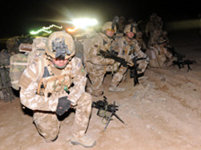 Nato-led forces say they are making good progress hours after launching the biggest offensive in Afghanistan since the overthrow of the Taliban in 2001.
Nato-led forces say they are making good progress hours after launching the biggest offensive in Afghanistan since the overthrow of the Taliban in 2001.There were clashes as more than 15,000 US, UK and Afghan troops swept into the Helmand districts of Marjah and Nad Ali in a bid to secure government control.
The Afghan Army said 70% of Marjah had been cleared, while a UK commander said 11 insurgent bases had been captured.
A Taliban commander reportedly said his men were retreating to spare civilians.
Operation Moshtarak - which means "together" in the local Dari language - is being led by 4,000 US Marines, supported by 4,000 British troops, with Canadians, Danes and Estonians.
'Heavily booby-trapped'
The BBC's Frank Gardner, with Nato forces at Kandahar airbase, says the test of the operation's success will not be on the battlefield.
It all depends on whether the coalition can hold the ground and bring lasting security and good governance to the population of central Helmand.
Hours after the attack was launched, three US soldiers were killed by an improvised explosive device, Nato said, although it is not yet clear if they were part of Operation Moshtarak.
Five members of the Taliban were killed and two arrested in the opening stages of the assault, Afghan officials said.
Troops have been advancing carefully, picking their way through poppy fields, trying not to set off Taliban bombs.
A canal bridge into Marjah was so rigged with explosives that US Marines had to erect temporary crossings to reach the town, reports the Associated Press.
Helmand Governor Gulab Mangal told a news conference the Taliban had "heavily booby-trapped the area", reports Reuters.
Afghan President Hamid Karzai, who approved Operation Moshtarak, warned troops to avoid civilian casualties, and called on Taliban fighters to lay down their weapons.
Nato says Marjah is home to the biggest community under insurgent control in the south.
'On the hop'
It was estimated there were between 400 and 1,000 militants based there before Operation Moshtarak was launched.
Marjah has also long been regarded as a linchpin of the lucrative network for smuggling opium - the raw ingredient used to make heroin - harvested from Helmand's poppy fields.
Nato Commander Maj Gen Nick Carter told the BBC that 11 objectives had already been taken and the offensive had been "so far extremely successful".
"Indeed it would appear that we've caught the insurgents on the hop - he appears to be completely dislocated," he said.
The offensive began with waves of helicopters ferrying US Marines into Marjah in the early hours of Saturday.
British troops then flew into Nad Ali district, to the north, followed by tanks and combat units.
Jets and helicopters fired missiles at Taliban positions.
There have been firefights and sporadic insurgent rocket fire.
'Civilians in danger'
Mullah Mohammed - a Taliban commander in Marjah - told ABC News that his men were pulling back to spare any civilian casualties.
HAVE YOUR SAY We have little choice. We pull out, Pakistan falls. This is the era of the new domino theory. David Cheshire, Dorset, UK
"We found civilians in massive danger so we decided to go backward just to save villagers' lives," he said. His claim cannot be verified.
Nato had distributed leaflets in the Marjah area warning of the planned offensive in a bid to limit civilian casualties.
Earlier this week British forces began a "softening up" process, taking part in a Nato ground and air offensive on insurgent positions.
For the first time Afghan forces have been at the forefront of planning and will share the burden of the fighting.
It is the first major offensive since US President Barack Obama ordered a "surge" of 30,000 extra troops to Afghanistan in December.
More than 1,900 Afghan police will provide support after the initial military operations end, and a large team of Afghan administrators has been assembled.
The operation is part of an effort to secure a 320-km (200-mile) horseshoe-shaped string of towns that runs along the Helmand River, through Kandahar and on to the Pakistani border.
The area holds 85% of the population of Kandahar and Helmand.



